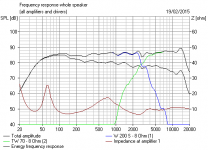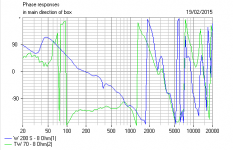hi
just trying to understand something what may appear comon sense/ second knowledge to others.
all speakers have a range on the 20-20 scale lets say,
but what i am trying to learn is
they need a cut off point towards the lower scale regards breaking up not been able to reproduce, but what about the higher up the scale of the speaker when breaking up/dropping off.
hope this makes sense

A will have a low pass filter to compensate C
but does point B need anything to compensate D
the quick scetch is over exagerated and should compensate a woofer taking over and a tweeter at points C and D
just trying to understand something what may appear comon sense/ second knowledge to others.
all speakers have a range on the 20-20 scale lets say,
but what i am trying to learn is
they need a cut off point towards the lower scale regards breaking up not been able to reproduce, but what about the higher up the scale of the speaker when breaking up/dropping off.
hope this makes sense

A will have a low pass filter to compensate C
but does point B need anything to compensate D
the quick scetch is over exagerated and should compensate a woofer taking over and a tweeter at points C and D
what about the higher up the scale of the speaker when breaking up/dropping off.
Some two way speaker systems do use the natural woofer hf rolloff to match with the tweeter. See the Dynaco A25 for a good example.
Otherwise, a wider response on the top end of the woofer range than necessary is needed, so that the crossover network works accurately.
The same goes for the low end of the tweeter.
Last edited:
The answer should be a bit more complete as the question is a bit vague.
If that FR is from a woofer, you typically do nothing on A, and do something on B or on a frequency < B (a low pass filter) if:
1) B is higher than the crossover point you want
2) the natural rolloff is not what you need (example 1st order acoustical and you need more)
On the other hand if the FR is from a mid or tweeter, you need to create a high pass filter on a frequency > A, even if the rolloff you see before A appeals you, because driving full range a mid or a tweeter will limit severely the power you can put on that driver.
Point B for a mid works the same as a woofer, point B for a tweeter should be a non issue as it should be more or less at 20KHz (so do nothing).
Ralf
If that FR is from a woofer, you typically do nothing on A, and do something on B or on a frequency < B (a low pass filter) if:
1) B is higher than the crossover point you want
2) the natural rolloff is not what you need (example 1st order acoustical and you need more)
On the other hand if the FR is from a mid or tweeter, you need to create a high pass filter on a frequency > A, even if the rolloff you see before A appeals you, because driving full range a mid or a tweeter will limit severely the power you can put on that driver.
Point B for a mid works the same as a woofer, point B for a tweeter should be a non issue as it should be more or less at 20KHz (so do nothing).
Ralf
The first thing you need to understand is that the cone breakup region is reasonably constant for ANY driver. A 8" breaks up at 3kHz, a 6" at 5kHz and a 5" around 7kHz. That's geometry. This is an 8" paper cone with a simple coil.
By using a more damped material for the cone, like plastic, or a big 8" or 10" heavy paper cone you have natural rolloff at these frequencies which helps.
H1471-08 CA22RNY
With small paper or metal cones you will need some more filtering effort.
H1456-08 ER18RNX
Cone breakup isn't always obvious on a frequency response. But the S shaped kink in phase at 3kHz for a paper 8" below is the first serious breakup mode.
An externally hosted image should be here but it was not working when we last tested it.
By using a more damped material for the cone, like plastic, or a big 8" or 10" heavy paper cone you have natural rolloff at these frequencies which helps.
H1471-08 CA22RNY
With small paper or metal cones you will need some more filtering effort.
H1456-08 ER18RNX
Cone breakup isn't always obvious on a frequency response. But the S shaped kink in phase at 3kHz for a paper 8" below is the first serious breakup mode.
Attachments
- Status
- This old topic is closed. If you want to reopen this topic, contact a moderator using the "Report Post" button.

